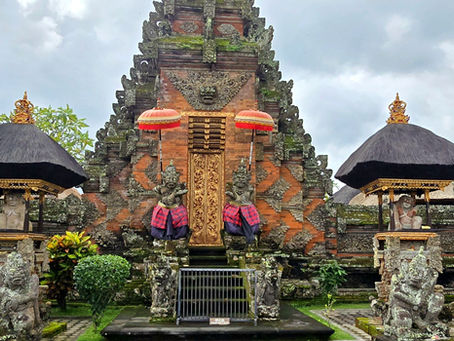top of page

GLOBAL SHANANIGANS

Search
Bali


The Moon of Pejeng - Temple of the Bronze Drum
Pura Penataran Sasih, founded in 1266 AD, was once the state temple of the Pejeng kingdom. Set in the fertile Petauan River valley, it reflects Bali’s ancient ties between ritual and agriculture. At its centre lies the Moon of Pejeng, a 2000 year old bronze drum and the largest single-cast of its kind in the world.
Shannon


Queen of Demons - The Legend of Rangda
Evoking both fear and intrigue, the Balinese divinity known as Rangda stands as a terrifying yet essential force within the island's spiritual and cultural landscape. She is more than just a monstrous figure, she is the embodiment of ultimate darkness, chaos and destruction, the shadow side of the cosmos that cannot be ignored or denied.
Shannon


Kajeng Rice Fields Loop
Slicing through glittering, gently terraced rice fields and fringed by towering coconut palms, the Kajeng Rice Fields Walk is arguably one of the prettiest treks you can do in the cultural capital of Ubud without a guide. Kajeng offers a rare and intimate glimpse into Bali’s traditional agricultural life, set against a landscape that’s both serene and alive with quiet purpose.
Shannon


The Ogoh Ogoh Museum of Demons
Each March, as Bali prepares for the eerie silence of Nyepi, grotesque effigies of demons and witches are paraded through the streets before being set aflame. Yet not all are consigned to fire, some escape their ritual death and find a resting place in the Ogoh Ogoh Museum, a shadowy graveyard of towering statues where the spirits of chaos seem forever frozen in time.
Shannon


Sangeh Monkey Forest
Sprawled across 14 hectares of ancient forestland, Sangeh Monkey Forest, also known as Obyek Wisata Bukit Sari Sangeh, is one of Bali’s most enchanting natural sanctuaries. Towering nutmeg trees, some reaching over 40 metres tall, dominate the landscape, creating a high green canopy that diffuses the tropical light and hushes the sounds of the outside world. But what truly sets this forest apart is its origin story. According to legend, the trees were not planted, they walked
Shannon


Barong - King of the Good Spirits
Barong is one of the most iconic and revered figures in Balinese mythology, embodying health, good fortune and divine protection. More than just a mythical creature, Barong is believed to act as a guardian angel, accompanying each person through life and shielding them from harm. He is the leader of the hosts of good and the eternal nemesis of Rangda, the dreaded Widow Queen.
Shannon


Gunung Kawi Sebatu - Mayadenawa's Curse
Gunung Kawi Sebatu is one of Bali’s lesser visited yet most serene temple complexes, nestled in the forested highlands of Sebatu village. Established during the 11th century, its origin is tied to the ruthless reign of King Mayadenawa, a figure known in Balinese lore for defying the gods. The temple is dedicated to Vishnu, the Hindu preserver deity and features crystal-clear spring pools, manicured gardens and a peaceful atmosphere that belies the legend tied to its sacred wa
Shannon


The Royal Palace of Ubud
In the heart of Ubud, the Royal Palace stands as a stunning showcase of Bali’s rich history and artistic spirit. Built around 1640, this elegant complex of pavilions and gardens offers a glimpse into the lives of the island’s royal family while pulsating with cultural performances and traditional ceremonies that keep Ubud’s heritage alive.
Shannon


The Rice Terraces of Tegallalang
Carved like emerald steps into Ubud’s natural amphitheatres, locals say the spirit of the rice goddess still watches over the iconic Tegallalang Rice Terrace, blessing the fields with life and balance. Also known as Ceking, the terraces are a large collection of beautiful verdant rice paddies, carved into the hillside by generations of farmers and shaped by centuries of Balinese ingenuity.
Shannon


Bali’s Buried Past - Blood on the Island of the Gods
One of the most horrific chapters in Balinese history occurred during the anti communist purges which swept across Indonesia in the mid 1960's and barely anyone dares talk about it. In the years leading up to the massacre, Bali was already a fractured island, mirroring the deepening political and social divisions across Indonesia.
Shannon


Taman Ayun - The Royal Playground
Encircled by a wide moat and wrapped in manicured geometric gardens, Pura Taman Ayun looks more like a mythical vision than a temple. This 17th-century royal fortress served as the royal temple of the once mighty Mengwi kingdom and was designed not just to honour the gods but to remind subjects of the divine order that placed kings just beneath them.
Shannon


Campuhan Ridge Walk
On the Campuhan Ridge Walk, gentle paths wind past terraced rice fields, jungle valleys and scattered temples. It’s an effortless stroll, yet every step resonates with the echoes of centuries old Balinese culture.
Shannon


Vihara Dharmayana - The Dragon Pagoda
Established in 1876, Vihara Dharmayana stands as one of the oldest Buddhist temples in Bali and the only one of its kind in Kuta. Known locally as Kongco Kuta, the temple was built to honour Tan Hu Cin Jin, a Chinese nobleman and architect who served the King of Mengwi. The site was famously visited by the 14th Dalai Lama during his tour of the island in 1982.
Shannon


Kehen - The Temple of Fire
First mentioned in ancient copper inscriptions from the 9th century, Kehen Temple was originally known as Pura Hyang Api, a sacred site dedicated to Agni, the Hindu God of fire. This powerful deity symbolises not just destruction but also renewal and purification, embodying the transformative force of flame. Over the centuries, the temple underwent several name changes as it evolved with the shifting tides of Balinese history and spirituality.
Shannon


Sacred Monkey Forest Sanctuary
Hidden among dense jungle in Ubud, the Sacred Monkey Forest is a living tapestry of Balinese culture and nature. Ancient Hindu temples rise amid towering banyan trees, creating an atmosphere of quiet reverence. The forest invites visitors to step into a world where spiritual tradition, wildlife and natural beauty coexist seamlessly, offering a rare glimpse into Bali’s enduring heritage.
Shannon


Pura Dalem Ubud - The Temple of Death
In the shadowed heart of Ubud stands Pura Dalem, a temple steeped in ancient power and shadowed secrets. One of the area’s most formidable sacred sites, it pulses at the centre of the local spiritual life, a place where worship, dark rituals and otherworldly performances unfold. Its moss clad stone carvings depict guardian spirits and fearsome deities, whispering of life, death and the unseen forces that linger at the edge of perception.
Shannon


Yeh Pulu - Water of the Stone Jar
Hidden in a lonely ravine between the Petanu and Pakrisan Rivers, the ruins of this unique 14th-century rock relief lay buried for centuries under volcanic eruptions and vegetation. The site was excavated by Dutch authorities in 1925 and in 1949, a stone gutter was cemented on top in order to drain off water, to prevent erosion and vegetation from taking hold, revealing even more of the stone mural.
Shannon


Gunung Kawi Tampaksiring - The Mountain of Lost Kings
Carved into the rock cliffs on both sides of the Pakrisan River, this 11th century temple site and funerary complex is of profound historical and spiritual significance to the Balinese people. The name Gunung Kawi translates to the "Mountain of Poetry" but it is also affectionately referred to as the Valley of the Kings.
Shannon


Ulu Petanu Waterfall
Tucked deep within Tegallalang village, Ulu Petanu Waterfall offers a peaceful, intimate retreat far from Bali’s busy tourist spots, where crystal-clear waters cascade gently amid dense jungle. Steeped in legend, it is also known as the sacred site linked to King Mayadenawa, whose blood is said to have cursed the nearby river, making the waterfall a place of spiritual cleansing and reverence.
Shannon


Batuan Temple
In the heart of Batuan village stands Pura Puseh Desa Batuan, one of Bali’s oldest and most spiritually charged temples. Founded in 1020 AD and recorded in Balinese historical texts for over a millennium, it is rooted in something far older, believed to have been built atop a megalithic stone circle, echoing the ancient power of Stonehenge, where ancestral rites were once performed.
Shannon
bottom of page